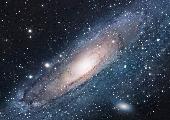
Andromeda Galaxy
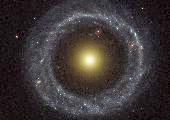
Hoag's Object
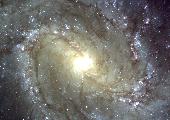
Southern Pinwheel Galaxy
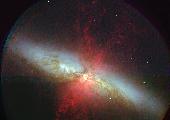
Cigar Galaxy
- In the year 964 A.D., the Arab Abd Al-Rahman Al Sufi described the Andromeda Galaxy as a small cloud. In 1612 Simon Marius first saw it through a telescope. At only 2 million light years, Andromeda, also known as M31, is our closest galactic neighbor. It is slightly larger than our own Milky Way galaxy but has the same organization to its 400 billion (400 x 109) stars. Although Andromeda's full angular diameter is seven times as much as the full Moon, it appears much smaller to the naked eye because only the central region is bright enough to be seen even on a truly dark sky night. (Double-Size Image) The Andromeda Galaxy will collide with our own Milky Way in about 3 billion years as it approaches at 140 kilometers per second. They will probably merge to form a single massive elliptical galaxy. Andromeda's right ascension is 00 h 42.8 m and its declination is +41� 16'.
- Discovered by Art Hoag in 1950, Hoag's Object is about the same size as our Milky Way but 600 million (600 x 106 or 600,000,000) light-years away. It may not be a single galaxy but rather two. The outer ring has many hot, young, blue stars while the center has mostly cooler, older, yellow stars. Between them, there are almost no stars. Today we give the collective name of "ring galaxy" objects of this type. Interestingly, a second but much more distant ring galaxy is visible in the clear space of Hoag's Object at about the One O'clock position.
- 1751-52 Abbe Nicholas Louis de la Caille discovered the Southern Pinwheel Galaxy, also called M83 and NGC 5236, in 1751-52, believing it to be a cloud of dust and gas. In the 20th Century, we resolved it as slightly barred galaxy with well-defined spiral arms. The red knots are regions of new star formation, and the blue regions are populations of young, hot, massive stars only a few million to a few tens of million years old. The dark, dusty lanes between concentrations of stars spiral well into the galactic nucleus. Older yellow stars make up the nucleus and inner portions of the bars. So far, astronomers have seen six supernovas in this nearby galaxy. Estimates for the distance to M83 range between 10 and 25 million light-years. The red shift suggests about 15, but the brightest stars can be resolved as individuals, implying a distance closer to 10. The diameter is about 30,000 light-years. Whatever the distance, even a small telescope resolves this beauty. You will find it at 13 37.0 right ascension and -29 52 declination with an apparent angular size of 11 x 10 and a visual brightness of 7.6.
- The Cigar Galaxy, 12 million light-years distant, recently passed the large spiral galaxy M81, helping to stir up this galactic super wind. Some astronomers think that perhaps the combined stellar wind from huge numbers of stars in the core account for the rest of the outpouring. The filaments are as much as 10,000 light-years long, aiding the Cigar to be the brightest infrared galaxy and clearly visible with a small telescope towards the constellation of Ursa Major. (Credit: APOD)
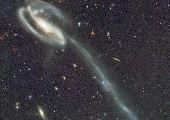
Tadpole Galaxy
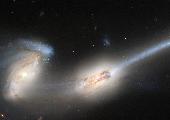
The Mice
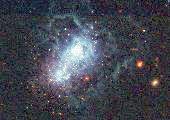
I Zwicky 18
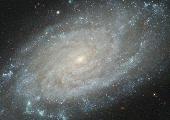
Spiral NGC 3370
- Set in the background of thousands of other galaxies, the large spiral Tadpole Galaxy lies 420 million light-years away in the constellation Draco. Another galaxy, visible through the upper left foreground spiral arms, slung around the Tadpole and now lies 300,000 light-years behind it. This close encounter drew out a streamer of dust, gas, and stars that is nearly three times as long as our own galaxy is wide. Like its namesake, this tadpole will probably lose its tail. The clusters of hot, young, massive, blue stars will break free of the Tadpole's gravity to form smaller satellite galaxies. (Credit: APOD)
- The Mice are a pair of colliding large spiral galaxies 300 million light years away in the constellation Coma Berenices that probably have made more than one pass through each other already. As they passed each other, differences in gravitational attraction between the near and far sides pulled out long streamers of dust, gas, and stars, giving them the appearance of having tails. (Double-Size Image) (Credit: APOD)
- The irregular dwarf galaxy I Zwicky 18 is a puzzle. We know that it is no more than 500 million years old because of two observations: we see no stars in it that are older than that, and we see almost no elements heavier than helium in the interstellar gas. Notice the predominant two knots of hot, massive, short-lived blue stars. Why did the primordial gas cloud wait more than 13,000 million years before it collapsed into a burst of star creation? Why did it wait when other nearby galaxies aged with the rest of the universe? Whatever the answer, then why did it start aging now? I Zwicky 18 ought to be way out on the edge of the observable universe near the beginning of time, but instead it is only 45 million light-years away. That is sort of like going deer hunting and finding the buck standing on your front porch staring you in the face when you open your front door.
- In November of 1994 the Spiral Galaxy NGC 3370 sported a new Type IA supernova. Digital detectors were new, and SN 1994ae was nearby and easily observed, as it was only 98 million light years away in the constellation Leo. This observation contributed the calibration data that led to the conclusion that the expansion of the universe is accelerating. (Double-Size Image) This photograph shows many Cepheid variable stars, dark dust lanes, tightly wound spiral arms, areas of bright new hot young massive star formation, and many background galaxies. Hubble obtained the intricate detail by using a full 24 hours exposure time. Without this much exposure time on the best telescope, we would not have been able to resolve the individual Cepheids and thereby calibrate the distance to the supernova.
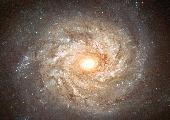
Spiral NGC 3982
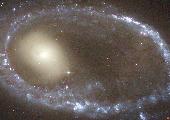
Ring AM 0644-741
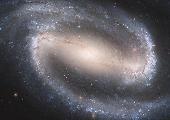
Barred Spiral NGC 1300
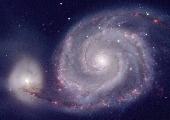
Whirlpool Galaxy
- William Herschel discovered NGC 3982 on April 14, 1789, incorrectly listing it as a planetary nebula. Spiral Galaxy NGC 3982 is about 60 million light years from our own in the direction of Ursa Major. Like our own, it contains spiral arms, dark dust lanes, and hot, young clusters of blue stars, but it is smaller at only 30,000 light years across. Astronomers studied this Hubble Space Telescope archival image taken before Supernova 1998aq to learn what the star was like before it exploded.
- Some astronomers think that ring galaxies form when a small galaxy passes though another, such as in the case of Ring Galaxy AM 0644-741. It was originally an Sa-Sab spiral galaxy 300 million light-years away towards the southern constellation Volans. The ring, looking like a blue diamond bracelet, is 150,000 light-years in diameter, which makes it large enough that our own entire galaxy could pass through it. (Double-Size Image)
The invading galaxy has already moved on. In its wake an expanding ring of gas clouds have condensed into hot young massive blue stars. The pink regions along the blue rim are also sites of intense star formation. These fluoresce as energetic ultraviolet stars knock electrons from the orbits of hydrogen gas in the clouds. The ring will expand for 300 million years before it breaks up.
- The Hubble Space Telescope took this picture in September 2004 of the Barred Spiral Galaxy NGC 1300. Its position is R.A. 03h 19m 40s.8, Dec. -19� 24' 40". At 70 million light-years away toward the Eridanus Constellation, it is 5.5 arcminutes wide or 110,000 light-years across, which is slightly bigger than our own Galaxy. It is so large that the Hubble needed to take two side-by-side viewings to include entire arm structure. (The large image here is actually half-size; the one listed as half size is a quarter size. The full picture is 6,637 by 3,787 pixels and 3.2 megs!) It resolves fine detail in this image such as individual giant stars, star clusters glowing red from hydrogen emission, and star forming regions. (Double-Size Image)
NC 1300 is an outstanding example of a barred spiral galaxy. They differ from regular spiral galaxies because the arms of the spirals form a straight line to the galactic core. Only galaxies with large bars show the "grand design disc" seen at the center. Gas funnels in along the bars to the 3,000 light-year wide disc where it may someday feed a super massive black hole. If there is such an object in the galaxy, it is quiet right now.
- Whirlpool Galaxy. (Double-Size Image)
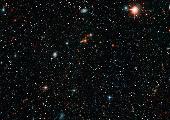
Hubble Deep Space
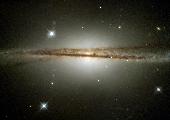
Edge-on Galaxy
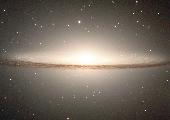
Sombrero Galaxy
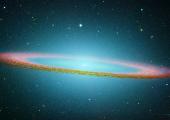
Sombrero In Infrared
- Although this Hubble Telescope deep space view is huge, it is only a quarter as wide and tall as the original monster file. Each point of light is not an individual star, but rather a galaxy composed of billions of stars. (Double-Size Image)
- The Hubble telescope took this shot of the Sombrero Galaxy, also called Messier 104 and NGC 4594, in visible light. Viewed from just six degrees above its equatorial plane, the The Sombrero is 28 million light-years away in the constellation Virgo. (Double-Size Image)
- With infrared light the Spitzer telescope reveals the bright, smooth ring of thick disc of dust surrounding the Sombrero galaxy. The slight warpage of the disc suggests a prior brush with another galaxy. Clumpy areas in the disc such as the right side show regions of new star formation. A billion solar mass black hole may exist because Spitzer sees bright infrared coming from the center of the galaxy. These two dramatic photos demonstrate the ability to astronomers to gather more infomation with infrared light than just visible light alone. The image is 9.6 arc minutes wide, almost a fifth the size of the full moon. Image Credit: NASA, JPL at Caltech, University of Arizona, and the SINGS team (Double-Size Image)